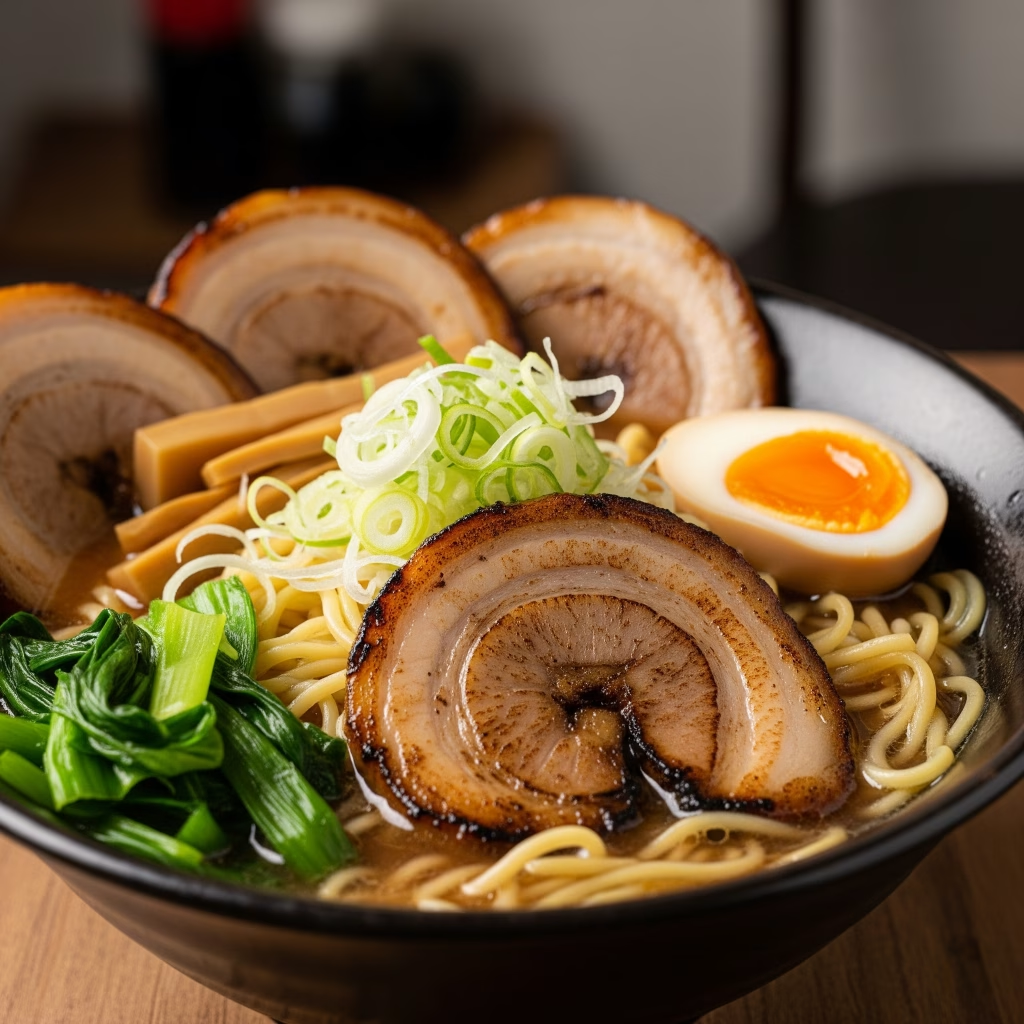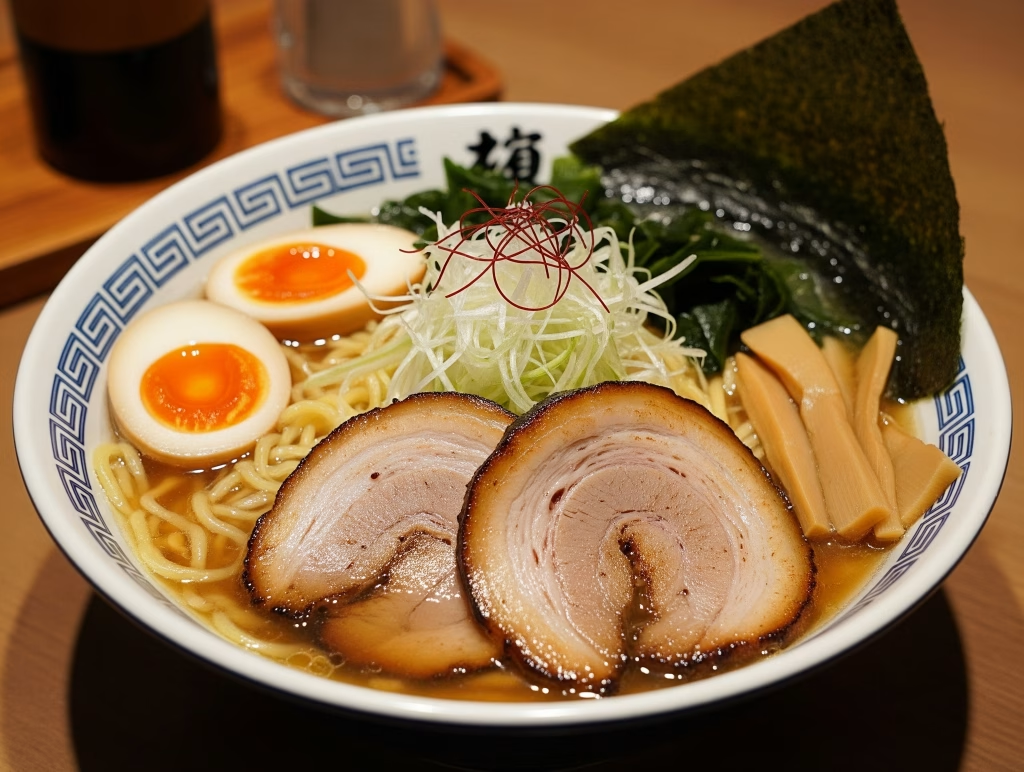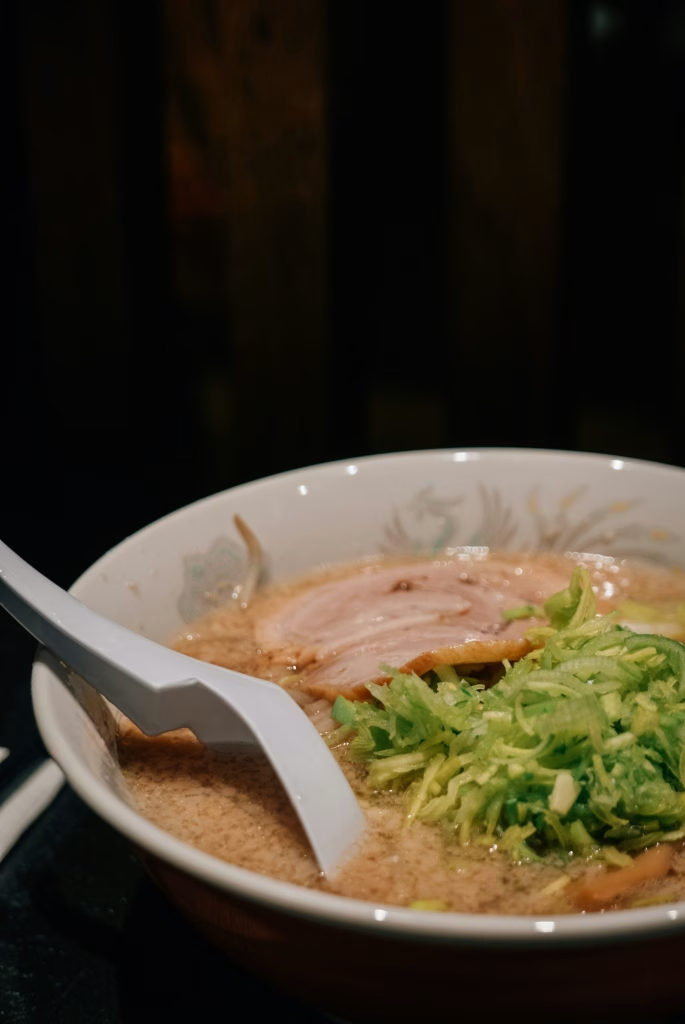Ramen is a beloved Japanese noodle soup dish known for its rich and savory broth, tender noodles, and variety of delicious toppings.
One of the most iconic toppings is Chashu Pork, which adds a savory, melt-in-your-mouth element to the dish. Chashu is slow-braised pork belly, seasoned with soy sauce, mirin, and other umami-rich ingredients.
This dish, Ramen with Chashu Pork, combines the perfect balance of flavors and textures, making it a staple in both Japanese restaurants and home kitchens. Whether you’re a ramen enthusiast or a beginner cook, this recipe will guide you through creating this hearty bowl of comfort food.
Table of Contents
Ingredients
For the Ramen Broth:
- 4 cups chicken broth (preferably homemade)
- 2 cups pork broth
- 2 tablespoons soy sauce
- 1 tablespoon mirin
- 1 tablespoon miso paste (optional, for added depth)
- 2 teaspoons sesame oil
- 1 clove garlic, minced
- 1 small piece of ginger, minced
- 1 tablespoon sake
- 1 teaspoon sugar
For the Chashu Pork:
- 1 lb pork belly, rolled and tied with kitchen twine
- 1/4 cup soy sauce
- 1/4 cup mirin
- 2 tablespoons sake
- 1 tablespoon sugar
- 2 cloves garlic, crushed
- 1 small piece of ginger, sliced
- 2 stalks green onions, chopped
- 1 tablespoon sesame oil
For the Ramen Noodles and Toppings:
- 4 servings ramen noodles
- 2 soft-boiled eggs
- 2 tablespoons green onions, chopped
- 1/4 cup nori (seaweed), sliced
- 1/4 cup bamboo shoots (optional)
- Bean sprouts (optional)
- Chili oil (optional, for spice)
Serves
This recipe serves 4 people.
Step-by-Step Instructions
Step 1: Prepare the Chashu Pork
- Sear the Pork: Heat 1 tablespoon of sesame oil in a large pot over medium-high heat. Sear the pork belly on all sides until golden brown (about 5 minutes). Remove the pork from the pot and set it aside.
- Make the Braising Liquid: In the same pot, add the soy sauce, mirin, sake, sugar, garlic, and ginger. Stir to combine and bring to a simmer.
- Braise the Pork: Return the seared pork belly to the pot and add enough water to cover the pork. Bring to a simmer, then cover and cook for 2-3 hours over low heat. Occasionally turn the pork to ensure even braising.
- Cool and Slice: After braising, remove the pork belly from the pot and let it cool. Once cooled, slice the pork into thin rounds.
Step 2: Prepare the Ramen Broth
- Heat the Broth: In a large pot, combine the chicken broth and pork broth. Bring to a simmer over medium heat.
- Add the Seasonings: Stir in the soy sauce, mirin, miso paste, sesame oil, garlic, ginger, sake, and sugar. Let the broth simmer for 10-15 minutes to develop the flavors. Taste and adjust the seasoning as needed (add more soy sauce or miso for depth).
Step 3: Cook the Ramen Noodles
- Boil the Noodles: Bring a large pot of water to a boil. Add the ramen noodles and cook according to the package instructions (usually about 3-4 minutes). Drain and rinse the noodles under cold water to stop the cooking process.
- Warm the Noodles: Before serving, briefly reheat the noodles in hot water to warm them through.
Step 4: Assemble the Ramen Bowls
- Place the Noodles: Divide the cooked ramen noodles among four bowls.
- Pour the Broth: Ladle the prepared ramen broth over the noodles, covering them completely.
- Add the Toppings: Place slices of Chashu pork, soft-boiled eggs, green onions, nori, and any additional toppings (bamboo shoots, bean sprouts) on top of the ramen.
- Garnish: Add a drizzle of chili oil if desired for a spicy kick.

Serving Suggestions
- Side Dishes: Serve your ramen with a side of gyoza (dumplings) or edamame for a complete meal.
- Pair with Green Tea: A warm cup of green tea pairs wonderfully with ramen, balancing the richness of the broth.

Tips for Perfect Ramen with Chashu Pork
- Slow Braise the Pork: The key to tender Chashu pork is to cook it low and slow. Patience is important to allow the pork to absorb the flavors and become melt-in-your-mouth tender.
- Customize Your Broth: The broth is the heart of ramen, so feel free to adjust the flavors to suit your taste. You can add extra miso for a richer taste or more soy sauce for saltiness.
- Use Fresh Ramen Noodles: Fresh ramen noodles give the best texture and absorb the broth wonderfully. If you can, use fresh noodles instead of dried.
- Soft-Boil Eggs Perfectly: For a perfect soft-boiled egg, boil for 6-7 minutes for the ideal creamy yolk. Quickly cool them in ice water to stop further cooking.

Healthier Alternatives
- Lean Pork: You can substitute pork tenderloin for the fatty pork belly to reduce the fat content while still maintaining flavor.
- Vegetarian Option: Use a plant-based ramen broth (such as mushroom or vegetable broth) and substitute tofu for Chashu pork for a vegetarian version.
- Low-Sodium Broth: Opt for low-sodium soy sauce and low-sodium chicken broth to reduce the sodium content in your ramen.
Creative Variations
- Spicy Ramen: Add a dollop of sriracha or chili paste to your broth for a fiery version of this dish.
- Seafood Ramen: Instead of Chashu pork, top your ramen with shrimp, crab, or fish cakes for a seafood twist.
- Tonkotsu Ramen: For an even richer broth, make a tonkotsu broth by simmering pork bones for several hours to extract a creamy, umami-packed flavor.

Common Mistakes to Avoid
- Overcooking the Pork: Braising the pork too long can make it dry and tough. Keep an eye on it and ensure it remains moist and tender.
- Using Too Much Soy Sauce: While soy sauce adds depth to the broth, too much can make it overly salty. Start with a small amount and taste as you go.
- Not Draining the Noodles: After cooking the noodles, be sure to drain them thoroughly to avoid a watery bowl of ramen.
- Skipping the Soft-Boiled Egg: A soft-boiled egg adds richness and texture to the ramen. Don’t skip this delicious topping!
History of Ramen with Chashu Pork
Ramen, in its current form, is believed to have originated in Japan in the late 19th century. While Chinese immigrants brought noodle soup dishes to Japan, ramen quickly adapted and became its own cultural staple. The first ramen shops in Japan were inspired by Chinese noodle soups, but Japanese ramen evolved with distinct ingredients such as shoyu (soy sauce), miso, and tonkotsu (pork bone broth).

Chashu pork, as a topping, was introduced to ramen in the 20th century and became a classic part of the dish. The pork belly is braised in a savory, sweet liquid until it becomes incredibly tender and flavorful. Chashu pork is now considered one of the most beloved ramen toppings, known for its melt-in-your-mouth texture and deep umami flavor.
Ramen’s popularity has grown worldwide, with ramen shops now found in cities across the globe. Ramen with Chashu pork has become a quintessential ramen dish, often seen in both traditional and modern interpretations of the dish.
FAQs About Ramen with Chashu Pork
1. Can I use a different type of meat for Chashu?
Yes, you can substitute chicken thighs or beef for the pork belly if you prefer a different protein.
2. Can I make the broth in advance?
Yes, you can make the broth ahead of time and store it in the refrigerator for up to 3 days. Reheat before serving.
3. How long should I cook the Chashu pork?
The pork should be braised for about 2-3 hours on low heat until it is tender and easily slices into thin pieces.
4. Can I make this recipe vegetarian?
Yes, use tofu or seitan in place of the pork, and opt for a vegetable-based broth.
5. How do I store leftover ramen?
Store the broth, noodles, and toppings separately in airtight containers. The broth will last for about 3 days, while the noodles should be used within 1-2 days.
6. Can I freeze the Chashu pork?
Yes, the Chashu pork can be frozen after braising. Wrap it tightly in plastic wrap and store in a freezer bag for up to 3 months.
7. What type of ramen noodles should I use?
Fresh ramen noodles are preferred for the best texture, but you can use dried ramen noodles as a substitute if needed.
8. Can I add more vegetables to the ramen?
Definitely! Add vegetables like spinach, corn, bok choy, or mushrooms for added nutrition and flavor.
9. Can I make the ramen broth spicy?
Yes, add chili oil or fresh chili paste to the broth for an extra kick of spice.
10. Is this recipe suitable for beginners?
While there are several steps, the recipe is beginner-friendly if you follow the instructions carefully. The result is well worth the effort!
Ramen with Chashu Pork is a comforting and flavorful dish that brings the authentic taste of Japan into your kitchen. With its rich broth, tender noodles, and melt-in-your-mouth Chashu pork, it’s sure to become a favorite. Whether you’re making it for a family dinner or impressing guests with your cooking skills, this ramen recipe is a guaranteed crowd-pleaser.


